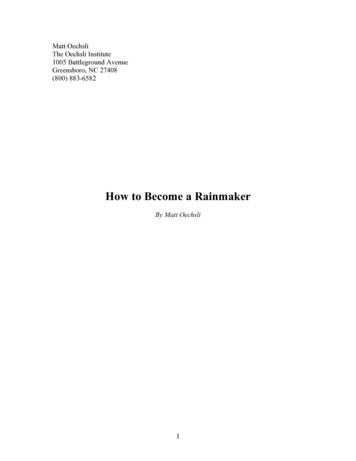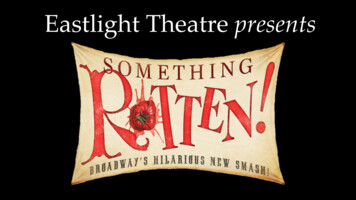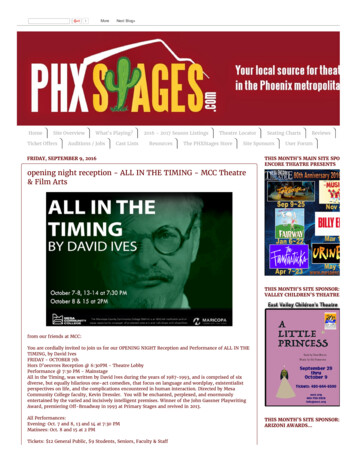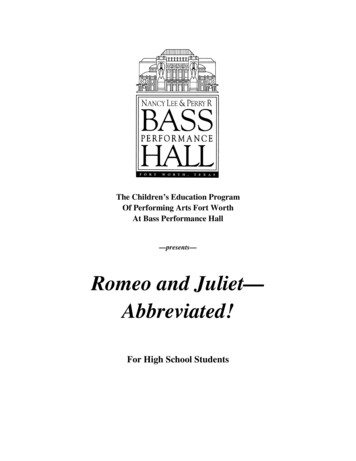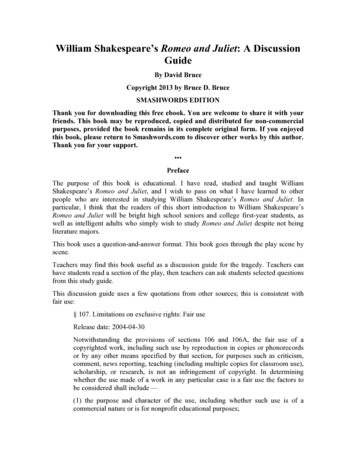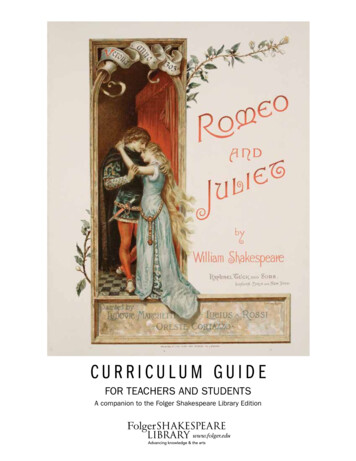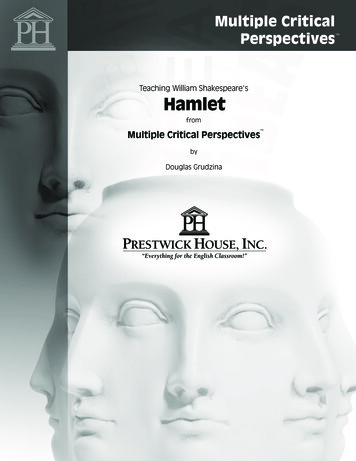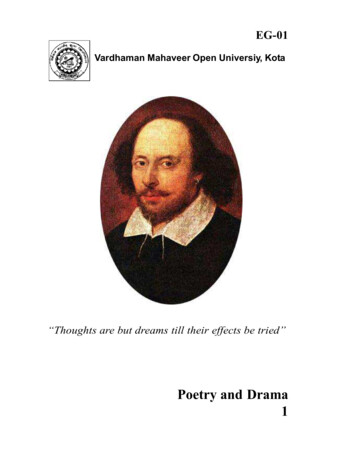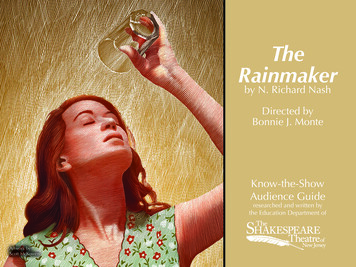
Transcription
The Shakespeare Theatre of New Jersey 2019THE RAINMAKER: Know-the-Show GuideTheRainmakerby N. Richard NashDirected byBonnie J. MonteKnow-the-ShowAudience Guideresearched and written bythe Education Department ofArtwork byScott McKowen
The Shakespeare Theatre of New Jersey 2019THE RAINMAKER: Know-the-Show GuideInthis Guide– The Rainmaker: Director’s Notes. 2– The Life of N. Richard Nash. 4– The Selected Writings of N. Richard Nash. 6– The Rainmaker: A Short Synopsis. 7– Who’s Who in the Play. 8– A Dream of Rain (and Con Men). 9– Commentary & Criticism. 10– In This Production. 11– Explore Online. 12– Famous Adaptations. 13The Rainmaker is presented by special arrangement with SAMUEL FRENCH, INC.1
The Shakespeare Theatre of New Jersey 2019THE RAINMAKER: Know-the-Show GuideThe Rainmaker:FROM THE PLAYWRIGHTDirector’s NotesLast summer, two of the gifted apprentices in our Summer ProfessionalI decided, then andTraining Program performed a scene for one of our late-nightthere, that I wantedpresentations that made me cry. It brought tears to my eyes not becauseto direct it this seasonit was sad, but because it was so moving and beautiful. It was a simpleand bring it to lifescene – a sweet encounter between two people, but it was so pure andfor our audience. Itender that it felt like I had suddenly encountered a clean place – onewanted to share whatunencumbered by the dirtiness and the constant bombardment of theI had experienced intrash “noise” of our modern world. It was a scene from The Rainmaker.reading it with you,onstage and in fulllife.I had never read the play, nor seen the film version. The very nextmorning, I searched my bookcase for a copy, and to my delight, I hadone; I sat down immediately and read it. When I got to the end, to myAfter working on itsurprise, I burst into tears – not just little tears, but a sudden burst offor a year now, I havesobbing – the kind of bursting into tears that we do when we are littlebeen further surprised“When drought hits the lush grasslands ofthe richly fertile West, they are green nomore and the dying is a palpable thing.What happens to verdure and vegetation,to cattle and livestock can be read inthe coldly statistical little bulletins freelyissued by the Department of Agriculture.What happens to the people of the West— beyond the calculable and terriblephenomena of sudden poverty and lossof substance — is an incalculable andfebrile kind of desperation. Rain willnever come again; the earth will be sereforever; and in all of heaven there is nopromise of remedy.”-N. Richard Nashfrom the Introduction to The Rainmakerand something scares us or startles us, thoughby the depth of theI was certainly not scared. But, I think theplay and its layers ofplay did startle me; it filled me with a kindcomplexity. It is tooof odd elation. Looking back now, I suspectoften dismissed as a romantic comedy, indeed, the author himself labeledthat what I was feeling was the ever-elusiveit as such. It certainly is romantic in the classical sense, it does containcatharsis that we yearn to feel when wesome romancing, and it has many funny moments, but it is an intenseexperience a piece of theatre. It felt so greatdrama — one that is often brutal in its honesty and in the painto have been swallowed up by a tale of suchthat its characters are going through. It operates on so manybasic, true, emotional universality that it filledarchetypal, symbolic, and iconic levels that it fits any andme with an overwhelming wave of emotions.all humans like a glove. It is poetic, yet domesticallyBonnie J. Monte, Director.2
The Shakespeare Theatre of New Jersey 2019THE RAINMAKER: Know-the-Show Guidefamiliar, and I suspect that given what has occurred in the world since itOne final note – for as simple a tale as The Rainmaker is, it is a verywas written that it carries far more weight than it did back in the 1950s.difficult play to perform. It requires brave actors who are willing to bedeeply vulnerable with each other and in front of an audience. I haveIt is a play about yearning, about desire, about a dire thirst for thingsbeen blessed with a cast of great skill, courage, and generous spirit.seemingly beyond our grasp, about family, about love and pain andWorking on this play has been a joy because of them, because of theloneliness, and it is, for me, most of all, a play about hope. In a timestory, and most importantly, because it is a play about decent, goodof great drought, a con man arrives in a small western town and bringspeople who manage to reveal, in the two hours we share with them,with him the promise of rain. Like so many archetypal bearers of gifts,the vast, complicated, beautiful, luminous caverns of the human heart.he is part snake-oil salesman, part shaman, part dreamer, wanderer,These simple, struggling people show us how we can help each other getpoet, weaver of tales, conduit, and showman. And while he is indeedthrough the droughts in our lives – both the real ones and those that area grifter and con artist, he is a good man, a lost man, and a man with ametaphorical.heart as big as his boasts and as vast in its yearnings as the western sky.-Bonnie J. Monte, DirectorAnd with him, he brings hope, and while hope may be the biggest conof all, it is one we all embrace, for it keeps us all going.Just a quick note about the time and place of the play: the authorsimply says that it takes place in the American West in a time of greatdrought. I do not think it is about the Dust Bowl era; I think ratherthat it was inspired by the great drought that plagued a ten-state regionin the American West and South – most notably Texas, Oklahoma,and Kansas from about 1950 to 1957. It was, by many accounts, farmore damaging than the effects of the Dust Bowl drought. It certainlychanged the landscape of Texas forever. [You can read more aboutthis drought by following the links in the Explore Online section ofthis Audience Guide.] I also think that so many references in the playindicate the world of the early 1950’s, and so we decided that ourproduction of the play is set on a cattle ranch on the Texas/OklahomaA dust storm in Texas during the 1930s Dust Bowl.Credit: NOAA. From livescience.comborder in 1953.3
ofThe Shakespeare Theatre of New Jersey 2019THE RAINMAKER: Know-the-Show GuideThe LifeN. Richard Nashattended the University of Pennsylvania. There and at Bryn Mawr andHaverford Colleges he taught drama, inspiring at least one of his earlyplays, The Young and Fair.In 1935 he married Helena Taylor, an actress, and with her had a son,Cristopher. In the late 1930s Nathan Nusbaum’s success attracted interestby the movie studios, so he and his young family moved to Los Angeles.It was in Hollywood that Nathan R. Nusbaum became N. Richard Nash.Cristopher remembers several conversations about how the name shouldbe chosen; one evening at the kitchen table, the family gathered around atelephone book. He recalls his father saying, “Nash, yes, that’s it.”N. Richard Nash, was born Nathan Richard Nusbaum in Philadelphia,PA, on June 8,1913. He was the youngest and only boy of 6 children.His father, Sael, a bit of a dreamer, convinced a German newspaperto send him to the U.S. as a stringer to cover a famous actress of thetime, Eleanor Duse. Sael Nusbaum insisted on continuing to followand report on her long after the newspaper had lost interest. and firedhim. As a boy, Nathan was taken by his father to nightly meetings oflocal political groups where he would curl up under the table, listeningto the barnstorming rhetoric of the activists of the time. Sael died whenNathan was 16.Nash created many screenplays for Hollywood and was soon also writingfor the Broadway stage during what came to be referred to as the GoldenAge of Television. He was also often called upon by Broadway producersNathan’s mother, Jenny Nusbaum was a tough, resourceful womanwho managed the family grocery store through the Depression, findingways to feed neighbors and passersby when they were down on theirluck. Jenny didn’t have much time or attention for Nate especiallyafter his father’s death. While his older sisters were marrying or gettingjobs, Nathan held to his dream of becoming a writer, earning prizesand acclaim — but not much money — in school and through writingopportunities as a young man. He attributed some of his early courageand success to the care and protection, in the family, of his older sister,Mae, who was, in part, the model for the enduring character Lizzie inhis most famous work, The Rainmaker.With a full scholarship to the college of his choice but unable to affordto leave Philadelphia in the midst of the Great Depression, NathanN. Richard Nash, from the N. Richard Nash Facebook page.4
The Shakespeare Theatre of New Jersey 2019THE RAINMAKER: Know-the-Show Guideto serve as a “play doctor” — a behind-the-scenes consultant and oftenwriter and editor of foundering plays readying for production.In the 1970s, as theatrical styles were changing, Nash adopted a newvoice under the pseudonym, John Roc. As Roc, he wrote two very darkworks, Fire! a play, and Winter Blood, a novel. Nash was convinced thatno one would take these works seriously if written under his own nameand managed to keep the secret from almost everyone but his immediatefamily until his memorial service in the spring of 2001. After he died,friends discovered two other pseudonyms under which, as far as one cantell, he never published. But there’s always a mystery.When Cristopher was 16, Nash and his wife divorced and Nash movedto New York. There, he met and soon married Janice Rule, an actress.That marriage was short-lived and soon after, Nash met and marriedKatherine Copeland, an actress and television host. They had twochildren, Jennifer and Amanda.*Biography from nrichardnash.comN. Richard Nash continued to write for Hollywood where he workedwith, among others, Samuel Goldwyn at Metro Goldwyn Mayer. Nashhad many stories about Goldwyn, including Goldwyn’s now famoushabit of calling Nash after reading one his scripts to say, “Richard, it’sperfect! Now come and fix it.” Katherine Nash also recalled a warmrelationship with Goldwyn who seated her at his right at one of hismany big dinner parties. At the time, Katherine was pregnant withher first child and unaccustomed to managing her bulk. Apparently,she spilled a glass of wine directly into Goldwyn’s lap. Graciously, hedid not budge, but all the neighboring dinner guests tossed her theirnapkins.OTHER CAREERSVery early on, though, long before Nash got established as adramatist, he also did a stint at the advertising agency NW Air,where he is said to have originated a number of very successfulcampaigns, including the “A diamond is forever” slogan forDe Beers. He also told a story of having saved NW Air fromembarrassment when the agency was on the verge of launching anew toothpaste, Dreck, which means “excrement” in Yiddish.Over the course of his life, Nash wrote for the theater and the screen.Later, Nash wrote fiction, and two of his novels found their ways to theNew York Times bestsellers list: East Wind, Rain, and The Last Magic.In the early 1960s during a lull in his career and in an effort toacquire a full wood-working shop, he also created and operated asuccessful mail-order company, Country Crafts, through which hesold reproduction furniture that he made and marketed himself.He closed the business when he received an order so large fromBloomingdales than he felt uncomfortable about being able to fillit.Missing the experience he’d had at the beginning of his career teachingat Bryn Mawr, Haverford, and the University of Pennsylvania, Nashreturned whenever he could make time to teach at many academicdrama departments including Yale, Princeton. and Brandeis Universities.He loved teaching and was a warm, engaging, but firm instructor. Hissingle, most consistent admonishment to young writers: “Finish it!”5
ofThe Shakespeare Theatre of New Jersey 2019THE RAINMAKER: Know-the-Show GuideThe Selected WritingsN. Richard NashMUSICALS:-Wildcat, 1960-110 in the Shade (1963) a musical adaptation of The Rainmaker.-The Happy Time, 1968-Sarava, 1979SELECTED SCREENPLAYS:Nash penned over a dozen screenplays (1946–1959), including:-“The Rainmaker” (based on Nash’s play), 1956-“Porgy and Bess” (adapted from Gershwin’s folk opera), 1959PLAYSCRIPTS:As N. Richard Nusbaum:-So Wonderful! (In White) (one-act), 1937-Incognito (three-act), 1941-Parting at Imsdorf (one-act), 1941-Sky Road: A Comedy of the Airways (three-act), 1941TELEPLAYS:For NBC: “House in Athens,” “The Rainmaker,” “The Brownstone,” “TheHappy Rest,” “The Young and Fair,” “The Arena.”For ABC: “Welcome Home” and “The Joker.”He also contributed to the teleplays for programs such as:“Philco Playhouse,” “General Electric Theater,” “U.S. Steel Hour,”“Television Playhouse,” and “Theater Guild of the Air.”As N. Richard Nash:-Second Best Bed, 1946-The Young and Fair, 1948-See the Jaguar, 1952-The Rainmaker, 1954-Girls of Summer, 1956-Handful of Fire, 1958-Echoes, 1973-Rouge Atomic, date unknown-Selected Plays (1997) with following plays, most still unproduced:The RainmakerEverybody, Smile!Breaking the TieAlchemyYes, Tom, Yes!The Green ClownThe Loss of D-NaturalBluebird of HappinessAs N. Richard Nash:Cry Macho, 1975East Wind, Rain, 1977The Last Magic, 1978Aphrodite’s Cave, 1980Radiance, 1983As well as two books on philosophy:The Athenian SpiritThe Wounds of SpartaAs John Roc:-Fire!, 1969As Jon Roc:Winter Blood, 1971BOOKS:6
The Shakespeare Theatre of New Jersey 2019THE RAINMAKER: Know-the-Show GuideTheRainmaker:matchmaking intentions right away and he declines the invitation. Themen return home and inform Lizzie. Disappointed, they are about to sitdown to dinner, when a stranger appears at their door.A Short SynopsisEnter Bill Starbuck, a “rainmaker” who claims that for a mere 100 hecan bring rain and end the drought. His fast-talking style does not workon Lizzie or Noah, but H.C. and Jim seem eager to take a chance on thistraveling man. Against Noah’s advice, H.C. agrees to pay Starbuck the 100. Starbuck asks the men in the family to assist in his endeavor. Jim isto beat a big bass drum to call up the thunder, H.C. paints a large whitearrow on the ground pointing away from the house to ward off potentiallightning strikes, and Noah is sent to tie the hind legs of a mule together.Please note: Below is a partial summary of the play. If you prefer not to spoilthe plot, consider skipping this section.The play opens in the home of the Curry family. It is a scorching,drought-ridden August morning. This prosperous ranching family nowfaces the crisis of a dwindling herd, as their cattle succumb to thedrought. Of possibly greater import to the family however is Lizzie.She is the only daughter of H.C. Curry, and she takes care of all thingsdomestic for her father and her two brothers, Noah and Jim. The everpresent concern on all their minds is that Lizzie, now well into an agewhen her peers are married, has no marriage prospects.Alone with Starbuck, Lizzie rages, claiming that he is not just content tosteal their money, but he is also making fools of them. Before leavingthe house, Starbuck targets Lizzie’s insecurities and calls her out fornot believing in anything — not even herself. When her father tries tocomfort her, Lizzie maintains that she would be better off if she was justan empty-headed flirt. As she is flouncing around the room to prove herpoint, File shows up at the door.As H.C. cooks up breakfast, we discover that Lizzie returned late theprevious evening from a visit to nearby Sweetriver, where it was hopedshe may have found a beau among some of her eligible cousins. Asthey wait for Lizzie to come down stairs, Noah, the eldest, looks overthe financial and feed ledgers and reprimands his younger brother Jimfor chasing after a local girl whom Noah considers “fast.” When Lizziecomes down, she reveals that the trip to Sweetriver was a bust.As tensions and the heat begin to spike, each of the characters in theplay is forced to confront truths about themselves and the ways inwhich they perceive themselves, others and the world. In the end, eachare profoundly changed by their encounter with the diviner known asStarbuck.The Curry men then decide to go into town to invite the local deputy,File, over for dinner, and they convince Lizzie to prepare a heartysupper. When they meet with File, however, he catches on to their7
The Shakespeare Theatre of New Jersey 2019THE RAINMAKER: Know-the-Show GuideWho’s Whoin the PlayCostume rendering of H.C. Curry by CostumeDesigner, Hugh Hanson 2019.her beautiful. And yet, ironically, it is thisone unfulfilled part of Lizzie that is the mostpotentially beautiful facet of the woman —this yearning for romance — this courageoussearching for it in the desert of her existence.”“I don’t want a man to keel over! Iwant him to stand up straight — andI want to stand up straight to him!Without having to trick him! Isn’t thatpossible with a man?! ”Character descriptions are from N. Richard Nash’s script. Characters are listedin order of appearance.H.C. CURRY – “He is in his mid-fifties, powerfully set, capable, a good man totake store in. But he’s not all prosaic efficiency — there’s a dream in him.”“If you let ‘em live — people pay off better than cattle.”NOAH CURRY – “His eldest son.He is somewhat like his father, withoutH.C.’s imagination. As a matter of fact, he has little imagination at all — asomewhat self-righteous man, rigidly opinionated.”“I’m tryin’ to keep this family goin’! I’m trying’ to keep it frombreakin’ its heart on one foolishness after another! And what doI get for it?! Nothin’ but black looks and complaints!”FILE – “He is a lean man, reticent, intelligent. Hesmiles wryly at the world and at himself. Perhaps he is a little bitter; if so, hisbitterness is leavened by a mischievous humor.”“There’s one thing I’ve learned! Be independent! If you don’t ask forthings — if you don’t let on you need things — pretty soon you don’tneed things.”JIM CURRY – “Jim is the youngest in the family, in his early twenties — but he’sbig and broad shouldered and looks older until he opens his mouth; thenhe’s a child. He isn’t very bright and this is a great cross. He is filled withinchoate* longing.”SHERIFF THOMAS – Sheriff of the town; seems fond of the people he works withand serves.“It ain’t right for you to shack up all by yourself.Especially after youbeen married. When you lose your wife, the nights get damn cold.”*inchoate (in - KOE - ut): adj. rudimentary; just begun, not fully formed or developed.“People want to get together — they oughta get together. It don’tmatter how, does it?”LIZZIE CURRY – “She seems a woman who can cope with all the aspects ofher life. She has the world of materiality under control; she is a goodhousekeeper; pots and pans, needles and thread — when she touchesthem, they serve. She knows well where she fits in the family — she isdaughter, sister, mother, child — and she enjoys the manifold elementsof her position. She has a sure ownership of her own morality, for thetenets of right and wrong are friendly to her — and she is comfortablyforthright in living by them. A strong and integral woman in every lifefunction — except one.no man outside the family has loved her or foundBILL STARBUCK – “He is a big man, lithe, agile — a loud braggart, a gentledreamer. He carries a short hickory stick — it is his weapon, his pointer, hismagic wand, his pride of manhood.”“You gotta take my deal because once in your life you gotta take achance on a con man! You gotta take my deal because there’s dyingcalves that might pick up and live! Because a hundred bucks is only ahundred bucks—but rain in a dry season is a sight to behold! You gottatake my deal because it’s gonna be a hot night—and the world goescrazy on a hot night—and maybe that’s what a hot night is for!”8
The Shakespeare Theatre of New Jersey 2019THE RAINMAKER: Know-the-Show GuideA Dream ofhis healthy 10,000 fee — San Diego officials assured him that he couldclaim responsibility for the rainstorm only as long as he also claimedresponsibility for the city’s 6,000,000 in lawsuits - but the spectaclemade him a national celebrity.Rain (and Con Men)Beyond its associations with con men and confidence tricks, the practiceof rainmaking in America also has its modest, community-based roots:these include rain dances employed by some Southwestern NativeAmerican tribes, who tracked weather patterns and offered to performrainmaking ceremonies for settlers in exchange for trade items, andtraditions of rain prayers in Christian farming communities.America’s tradition of traveling rainmakers dates back to the old west,though it saw its greatest burst of activity amidst the dust bowl droughtof the 1930s. In the beginning of the 20th century, Charles Hatfieldbecame an especially prolific rainmaker, traveling the country with aself-concocted blend of 23 chemicals “guaranteed” to attract water. Asrain appeared to follow wherever he set to work, Hatfield gathered sucha large and confident following that he was able to secure contractswith government agencies and municipalities across SouthernCalifornia, his fees ranging from 50 (today, around 14,000) to 10,000 (the equivalent of a staggering 282,000). Contrastingwith the bold personalities and colorful braggadocio of Midwesternrainmakers, Hatfield’s style was marked by a clean, professionaldemeanor and a solid base of scientific knowledge, which he usedto infuse his pitches with impressive, technical-sounding phrases.LEFT: PUBLIC DOMAIN/JIM LEE: Hatfield (picturedhere) went around dried up Southern California tooffer his help.BELOW: Charles Hatfield (on the ladder) and hisyounger brother with one of their rain towers, inCoalings, Calif, circa 1915. Reprinted in the LOSANGELES TIMES, 2015.While he employed most of the strategies typical among rainmakers— building large “evaporating tanks” in the center of town to createthe appearance of a man hard at work, planning his visits so thatthey fell precisely at the desperate end of a dry season, establishinglong contracts meant to conveniently spill into the rainy season— Hatfield was unique in that he almost never failed.and that insome cases, his “successes” were near-biblical in their scale. In1915, San Diego officials signed a 10,000 contract with Hatfield,and less than one month later, the city was bombarded with weekslong torrents of rain powerful enough to break the Otay dam, leavethousands homeless, and cause several deaths. Hatfield never collected9
The Shakespeare Theatre of New Jersey 2019THE RAINMAKER: Know-the-Show Guide&CommentaryCriticismCostume researchand renderingfor Jim Curry, byCostume DesignerHugh Hanson.“[The Rainmaker] is a pre-feminist, old-fashioned three-act presentationof a time when women stayed at home and did all of those wifely thingslike cooking and cleaning.”Talking Broadway“What is most fantastic about this bolt of moonshine is that animpressive amount of it strikes home. This is partly due to a slightlyskeptical grin that author and characters persist in keeping on theirfaces. Nobody believes in the rainmaker. Nobody pretends that thegirl of the house is really pretty. Nobody strives to kid the audienceinto anything they;re not ready to believe on their own. As a result, alot of long-standing guards go quickly down; there’s room for jubilantnonsense, and moonlit sadness, to slip through.”Walter Kerr, NY Herald Tribune in areview of the original 1953 productionor any of Williams’ histrionicheroines. But in his own way, Nashis just as concerned as Williams andMiller about the effect of dreams — deferred and otherwise — as theybegin to dry up with age, or at least go into hiding behind weatheredwooden walls.”-Kerry Reid, The Chicago Tribune“Despite its sometimes antiquated surfaces and sounds, the subtext ofthe play is solidly rooted in home truths: Love is never easy to find orkeep, it is as hard to live with dreams as it is to live without them, and thepower to heal wounds the world inflicts mostly resides in our own heartsand minds. There’s a heap of poetry in this plain-spoken tale of a womanwhose beauty only receives its tribute when she believes in it herself.”-Charles Isherwood, Variety“Nash’s 1954 play about Lizzie Curry, a woman just this side ofspinsterdom whose romantic hopes are reignited when grifter/dreamerStarbuck shows up on the parched cattle ranch owned by her father andrun by her two brothers, occupies its own cozy niche in mid-centuryAmerican drama. Despite the backdrop of economic and environmentalhardship, it’s not an Arthur Miller-like exercise in realism and socialcommentary. Nor is it as fraught with psychosexual tension as TennesseeWilliams — no one would mistake sensible Lizzie for Blanche DuBois“Nash’s play is really about the tricky — and very American — balancingact between pragmatism and idealism.”-Kerry Reid, The Chicago Tribune10
InThe Shakespeare Theatre of New Jersey 2019THE RAINMAKER: Know-the-Show Guidethis ProductionRIGHT: Digital Rendering of the set design and paintelevation for the stage floor.BELOW: Research boards and costume renderings byCostume Designer Hugh Hanson 2019.11
The Shakespeare Theatre of New Jersey 2019THE RAINMAKER: Know-the-Show GuideExplore OnlineExamine the reality of the devastating drought that rocked Texas in the50s in the NPR article by John Burnett lore the realities life during a drought and the American Dust Bowlin this 9-minute PBS American Experience st-bowl-chapter-1/Texas Monthly’s article “When the Sky Ran Dry” looks at the Texasdrought through first-hand accounts from those who lived through sky-ran-dry/12
The Shakespeare Theatre of New Jersey 2019THE RAINMAKER: Know-the-Show GuideFamousAdaptationsTHE RAINMAKER (1956 film)In 1956, N. Richard Nash’s play TheRainmaker was adapted into a film directedby Joseph Anthony. It starred Burt Lancasteras Starbuck and Katharine Hepburn as Lizzie.The film was nominated for two AcademyAwards — Katharine Hepburn for Best Actressand Alex North for Best Music. The film wasalso nominated for four Golden Globes,including: Golden Globe for Best MotionPicture (Drama), Golden Globe for BestActor: Burt Lancaster, Golden Globe for BestActress: Katharine Hepburn, and Earl Holliman(Jim Curry) won the Golden Globe for BestSupporting Actor.110 IN THE SHADE (1963 & 2007 Broadway musical)Musical with a book by N. Richard Nash, lyrics by Tom Jones, andmusic by Harvey Schmidt. The originalBroadway production, directed by JosephAnthony and choreographed by Agnes deMille, opened on October 24th, 1962 atthe Broadhurst Theatre. The show ran fortwo previews and 330 performances. Thecast included Robert Horton as Starbuck,Inga Swenson as Lizzie, Stephen Douglassas File, and Will Geer, Lesley Ann Warren,Gretchen Crywe in supporting roles. The show was nominated for fourTony Awards.THODASA ROOMANI HO JAAYEN(1990 Bollywood film)This Hindi film adaptation was directed byAmol Palekar and starred Anita Kanwar asBinni (Lizzie) and Nana Patekar as Natwarlal(Starbuck), with a name drawn from aninfamous Indian conman. Its title, taken fromone of the film’s songs, translates to “let us allbe a little romantic”. Shriram Iyengar wroteof it, “The film continues to raise that mostAustenian question: Why is society moreinterested in a girl’s life than she herself is? Isit more important than a drought threatening the town? [.] Palekar hassucceeded in raising questions about the freedom of choice enjoyed bywomen in Indian society.” (Cinestaan, 2015).In the 2007 Broadway Revival, Audra McDonald played Lizzie Curry,Steve Kazee as Bill Starbuck, and John Cullumas H.C. Curry. Audra McDonald won theDrama Desk Award for Outstanding Actress in aMusical and was nominated for a Tony Award.Ben Brantley of the New York Times wrote onMcDonald’s performance: “Is it possible for aperformance to be too good? Audra McDonaldbrings such a breadth of skill and depth offeeling to the Roundabout Theater Companyrevival of 110 in the Shade that she threatens toburst the seams of this small, homey musical.”(New York Times, May 10th, 2007)13
The Rainmaker is presented by special arrangement with SAMUEL FRENCH, INC. e Shakespeare eatre of New Jersey 2019 THE RAINMAKER: Know-the-Show Guide Last summer, two of the gifted apprentices in our Summer Professional Training Program performed a scene for one of our late-night presentations that made me cry. .

